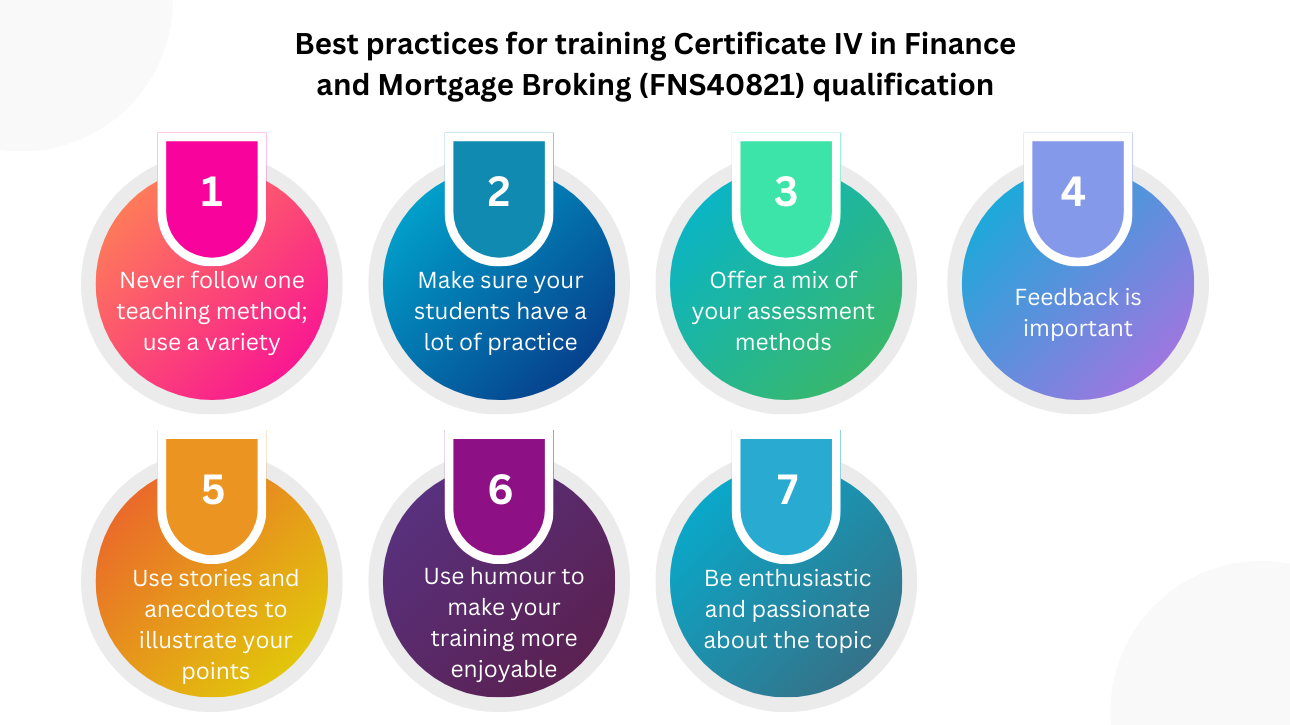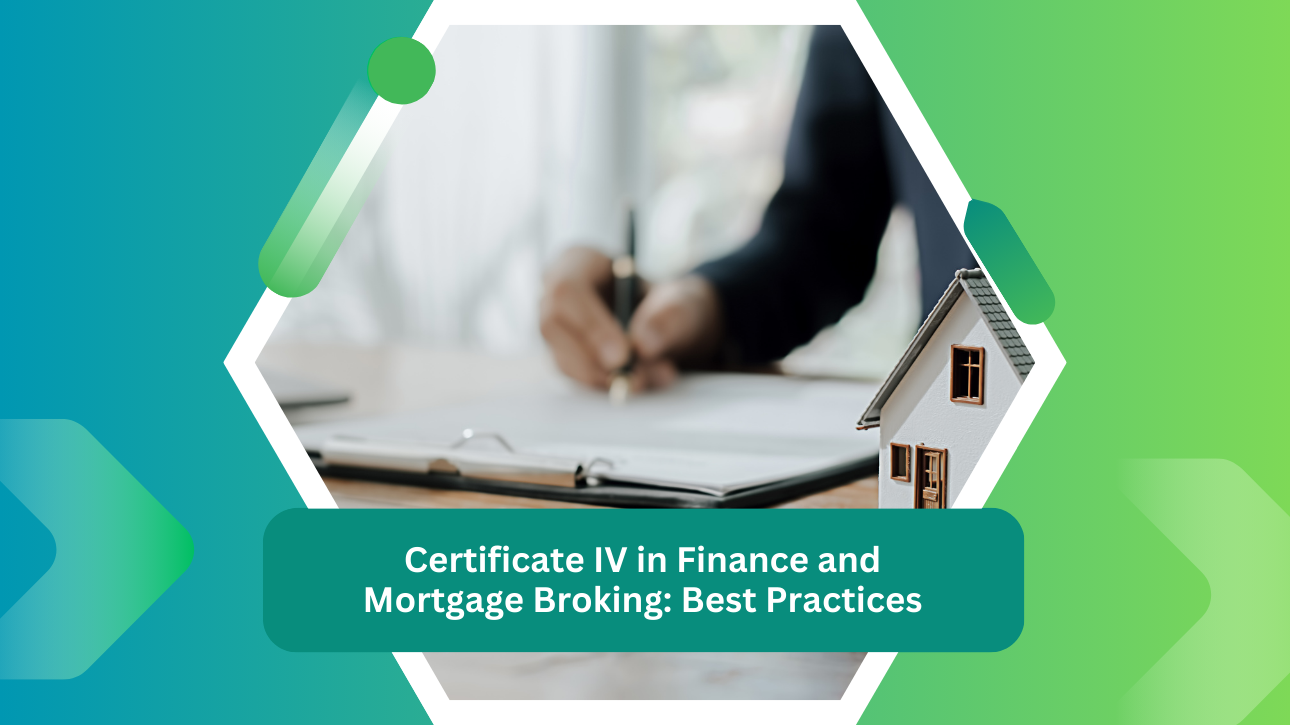Are you an RTO trainer or do you own a Registered Training Organisation? Are you struggling to train your students for the Certificate IV in Finance and Mortgage Broking (FNS40821) qualification?
And we understand the challenge of delivering high-quality training that is compliant while keeping up with the latest changes in the financial services industry is exhausting.
In this blog post, we will share best practices for training RTO students for the Certificate IV in Finance and Mortgage Broking qualification. These practices will not only keep you ahead of the competition but will also help you boost your completion rates. Let’s get started.
Best practices for training Certificate IV in Finance and Mortgage Broking (FNS40821) qualification

Our team has had many instances when RTOs failed to deliver the proper training, knowledge, and skills due to a few training mistakes. We have combined all our knowledge and prepared a list, so you never face defeat.
Never follow one teaching method; use a variety.
Some students learn best by listening, while others prefer doing. Use a mix of lectures, discussions, case studies, and role-playing exercises to keep your students engaged and learning.
Make sure your students have a lot of practice.
Provide your students with opportunities to practice their skills. The more practice your students have, the better prepared they will be for the assessment. Please give them the opportunities to practice filling out loan applications, calculating loan repayments, and giving financial advice. This way, you will prepare them for real-world situations.
Offer a mix of your assessment methods
Different students learn and perform best in different ways. Similarly, changing the assessment methods will tell you how the student performs using those methods. Different assessment methods, such as written exams, practical exams, and presentations, give your students a chance to succeed.
Feedback is important
In our experience, we have realised students never understand where they went wrong Unless they are given feedback about it. Give your students feedback on their assessments and give them tips on improving their skills.
Use stories and anecdotes to illustrate your points.
Students are more likely to remember information if presented in a story format. Chest from your own experience as a mortgage broker or your trainer’s experience to help your students understand the concepts they are learning.
Use humour to make your training more enjoyable.
A well-placed joke can make your trading more engaging and memorable for your students. Be careful not to go over it; you don’t want to distract from the learning process.
Be enthusiastic and passionate about the topic.
Your enthusiasm will be contagious, motivating your students to learn. Show your students that you are excited about the mortgage broking industry and believe in their ability to succeed.
Bonus tip
Create a community for your students. It could be an online forum, a Facebook group, or even a WhatsApp group. Providing your students with a space to connect and ask questions can be a great way to support learning and motivation.
Conclusion
Training students for the certificate in finance and mortgage Broking can be a challenging task, but it is also a rewarding one. By following the best practices outland in this blog post, you can give students the knowledge and skills they need to succeed in the mortgage broking industry. Remember, creating an engaging and supportive learning environment is the most important thing.
Use various teaching methods to make the learning relevant to the real world and provide your RTO students opportunities to practice Skills. Finally, remember to give your students speed back and provide them with a community where they can support and learn from each other.
By following these practices, you can help your students achieve their goals and become successful mortgage brokers.
Are you looking for the best training resources for the certificate for in finance and mortgage broking qualification?
VET Resources is your partner. We also offer free consultation to RTOs. For more information, please contact us here.
Frequently Asked Questions (FAQ)
Q1. What is the best course for a mortgage broker in Australia?
A1. The best course for mortgage brokers in Australia is the FNS40821 Certificate IV in Finance and Mortgage Broking. This nationally recognised qualification meets the Australian Securities and Investments Commission (ASIC) licensing requirements for mortgage brokers.
The Certificate IV in Finance and Mortgage Broking course will teach you the skills and knowledge you need to become a qualified mortgage broker, including:
- How to identify and assess client needs
- How to research and compare different mortgage products
- How to prepare and submit loan applications
- How to comply with relevant legislation and regulations
Q2. What does a Mortgage broker do?
A2. A mortgage broker is a financial intermediary who helps borrowers obtain mortgages from lenders. They work on behalf of the borrower to find the best possible mortgage terms and interest rates, based on the borrower’s financial situation and needs.
Mortgage brokers have access to a wide range of lenders, which gives them the ability to compare different mortgage products and find the best one for each borrower. They can also help borrowers with the mortgage application process, including gathering the necessary documentation and submitting the application to the lender.
Here are some of the specific things that a mortgage broker can do:
- Assess the borrower’s financial situation and needs
- Shop for mortgage products
- Prepare and submit the mortgage application
- Follow up with the lender
Q3. How much does a mortgage broker make in Sydney?
A3. Here is a breakdown of mortgage broker salaries in Sydney by experience level:
- Entry-level: $60,000 to $70,000 per year
- Mid-level: $70,000 to $90,000 per year
- Senior-level: $90,000 to $120,000 per year
Q4. What is the duration of FNS40821?
A4. The duration of the course will vary depending on each individual student and their prior experience and knowledge. 535 hours over a maximum of 12 months is the recommended timeframe for students new to the industry.
Q5. Why should RTOs include Certificate IV in finance and mortgage broking (FNS40821) in their training packages?
A5. There are several reasons why RTOs should include Certificate IV in finance and mortgage broking (FNS40821) in their training packages.
- High demand: The demand for qualified mortgage brokers is high, both in Australia and internationally. This is due to the growing complexity of the mortgage market and the increasing number of people seeking financial advice.
- Career opportunities: Certificate IV in finance and mortgage broking (FNS40821) can lead to a variety of career opportunities in the finance industry. Students who complete this qualification can work as mortgage brokers, personal finance brokers, investment brokers, or financial advisers.
- High earning potential: The earning potential for mortgage brokers is high. According to Glassdoor, the average salary for a mortgage broker in Australia is $98,500 per year. Top earners in the field can make upwards of $200,000 per year.
Q6. Where can you buy the best training material for FNS40821?
A6. The best training resources for FNS40821 are provided by VET Resources. Visit vetresources.com.au for more details on the offers.
Q7. What are some best practices for training on Certificate IV in Finance and Mortgage Broking (FNS40821)?
A7. Here are some best practices for training on Certificate IV in Finance and Mortgage Broking (FNS40821):
Use a variety of teaching and learning methods, such as lectures, workshops, and case studies.
Provide students with access to high-quality learning resources.
Encourage students to participate in active learning activities.
Assess students’ learning regularly and provide feedback
Q.8. What are the career opportunities for graduates of FNS40821 in the Australian mortgage industry?
A.8. Graduates can make career in the following jobs:
- Mortgage broker
- Loan officer
- Financial advisor
- Credit analyst
- Underwriter
- Settlement officer
- Home loan specialist
- Commercial loan specialist
- Mortgage aggregator
- Mortgage educator
- Mortgage compliance officer
- Mortgage risk manager
Q.9. What should be the RPL process for Certificate IV in Finance and Mortgage Broking (FNS40821) qualification?
A.9. The RPL process for the Certificate IV in Finance and Mortgage Broking (FNS40821) qualification will vary depending on your RTO, but there are some general steps that you can expect to follow:
- Apply for RPL. You will need to complete an RPL application form and submit it to your RTO.
- Your RTO will assess your RPL application to determine whether you are eligible for RPL.
- Completing the assessment. The assessment plan will outline the tasks that you need to complete to demonstrate your competence in the required skills and knowledge.
- Once you have completed the assessment, your RTO will assess your performance and determine whether you have met the requirements for RPL.
Disclaimer:
The information presented on the VET Resources blog is for general guidance only. While we strive for accuracy, we cannot guarantee the completeness or timeliness of the information. VET Resources is not responsible for any errors or omissions, or for the results obtained from the use of this information. Always consult a professional for advice tailored to your circumstances.






